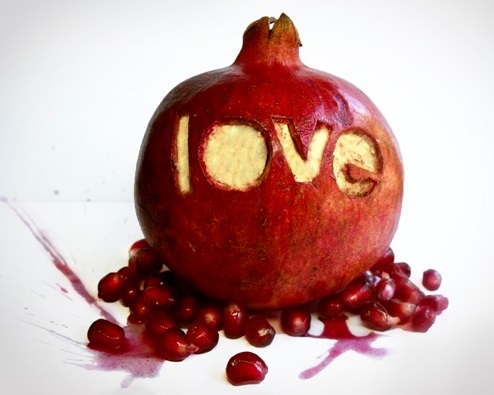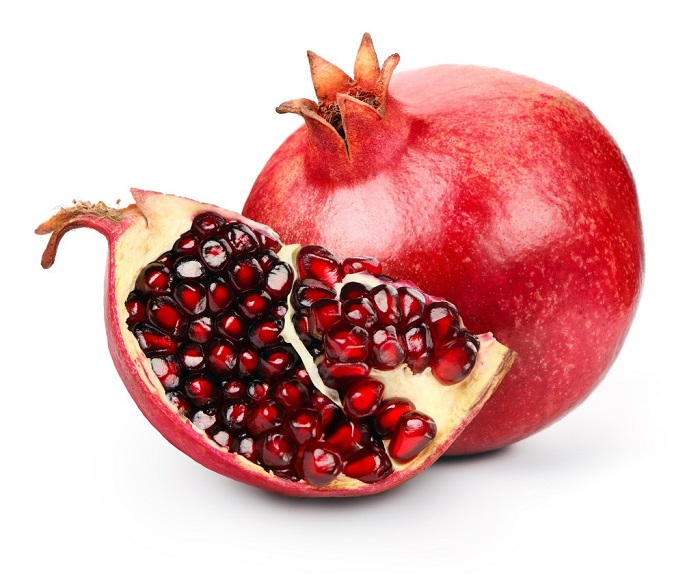Main Name: Pomegranate
Biological Name: Punica granatum
Names in other languages: Granada (Spanish), Grenade (French), Granada (Filipino), Anar (Hindi), Mathulam pazham (Tamil), Mathulam (Malayalam), Danimma pandu (Telugu), Dalamb (Gujarati), Dalim (Bengali), Dalimb (Marathi), Dalimba (Oriya), Anar (Punjabi & Urdu)
Biological Name: Punica granatum
Names in other languages: Granada (Spanish), Grenade (French), Granada (Filipino), Anar (Hindi), Mathulam pazham (Tamil), Mathulam (Malayalam), Danimma pandu (Telugu), Dalamb (Gujarati), Dalim (Bengali), Dalimb (Marathi), Dalimba (Oriya), Anar (Punjabi & Urdu)
Introduction
While strolling down a fruit market, don’t your eyes stop at the round, large, juicy red and shiny fruits? Pomegranates contain countless, tiny, ruby-coloured seeds that resemble gems and also yield delicious juice. These citrus flavoured fruits grow on small trees of about 5-8 meters in length in hot climatic conditions. The main advantage of pomegranate trees is that they can easily thrive for several years. Although only grown in countries like India, Africa and the United States, pomegranates are gaining popularity worldwide. It is possible to make refreshing drinks and mouth-watering dishes using the seeds from each segment of the fruit. Pomegranates are also used in preparations such as jellies, wines and salad dressings. Beside their terrific taste, these fruits carry a large amount of antioxidants that benefit the body. Pomegranate is a perfect fruit to snack on and keep you looking fit! Check out more about the nutritional advantages of pomegranates.
History
The pomegranate fruit is a native to Persia and the Western Himalayan range and it is considered to be one of the oldest fruits known to mankind. According to researchers, these fruits have been cultivated in countries like Iran, Azerbaijan, Afghanistan, Pakistan, Northern India, Russia and the Mediterranean region for thousand years now. The carbonized outermost layer (exocarp) of pomegranates was discovered during the Early Bronze Age levels of Jericho in Israel and in the Late Bronze Age levels of Hala Sultan Tekke in Cyprus and Tiryns. A significant amount of dried pomegranate was identified in the tomb of Djehuty, the butler of Queen Hatshepsut in Egypt. The ancient Mesopotamian cuneiform mentions this fruit from the mid 3rd millennium BC. Today, pomegranates are cultivated widely in South China and Southeast Asia although it is unclear whether they were originally yielded on the Silk Road route or brought by sea traders to this part of the world. It is also believed that the fruits were introduced to China in around 100 BC by the Han Dynasty representative, Jang Qian. The Romans referred to this fruit as ‘punic apple’. Interestingly, an ancient city of Granada in Spain was named after the fruit, during the Moorish period. Later, colonists of Spain introduced pomegranate to the Caribbean and Latin America, after which it was taken to England by John Tradescant. It did not gain too much popularity here initially and hence, was later reintroduced in American colonies and in New England as well.
The pomegranate fruit is a native to Persia and the Western Himalayan range and it is considered to be one of the oldest fruits known to mankind. According to researchers, these fruits have been cultivated in countries like Iran, Azerbaijan, Afghanistan, Pakistan, Northern India, Russia and the Mediterranean region for thousand years now. The carbonized outermost layer (exocarp) of pomegranates was discovered during the Early Bronze Age levels of Jericho in Israel and in the Late Bronze Age levels of Hala Sultan Tekke in Cyprus and Tiryns. A significant amount of dried pomegranate was identified in the tomb of Djehuty, the butler of Queen Hatshepsut in Egypt. The ancient Mesopotamian cuneiform mentions this fruit from the mid 3rd millennium BC. Today, pomegranates are cultivated widely in South China and Southeast Asia although it is unclear whether they were originally yielded on the Silk Road route or brought by sea traders to this part of the world. It is also believed that the fruits were introduced to China in around 100 BC by the Han Dynasty representative, Jang Qian. The Romans referred to this fruit as ‘punic apple’. Interestingly, an ancient city of Granada in Spain was named after the fruit, during the Moorish period. Later, colonists of Spain introduced pomegranate to the Caribbean and Latin America, after which it was taken to England by John Tradescant. It did not gain too much popularity here initially and hence, was later reintroduced in American colonies and in New England as well.
 http://brynhobson.com/365/2009/12/
http://brynhobson.com/365/2009/12/
Health Benefits of Pomegranate
- Pomegranates help women in fighting against breast cancer since its juice has the ability of eliminating cancer cells and preventing their growth. Consuming about 8 ounces of pomegranate juice daily helps in keeping levels of PSA stable, particularly if you are undergoing treatment for prostate cancer.
- Studies indicate that maternal consumption of pomegranate juice can prevent the neonatal brain from damage.
- Regular consumption of pomegranates prevents the formation of blood clots in arteries and assists in dissolving the same, if present. The seeds contain a fair amount of iron.
- Do you have high levels of cholesterol? Drinking a glass of pomegranate juice lowers LDL (bad cholesterol) and raises the HDL (good cholesterol).
- 1.7 ounces of pomegranate juice also assists in decreasing systolic blood pressure by almost 5%.
- Brushing your teeth twice a day is definitely a task! To give you teeth natural protection from dental plaque, consumption of pomegranate juice on a regular basis is recommended.
- The juice of this fruit also decreases the risk of heart strokes due to its excellent antioxidant properties.
- Women, during menopause, experience weakness and malaise. Pomegranate juice is extremely beneficial in giving the body a boost of energy and freshness.
- The fruit, pomegranate, is highly useful for people with a weak immune system. Eating the seeds of this fruit improves the defense mechanism of the body.
- A decoction made from the seeds of pomegranates is helpful in the treatment of syphilis while the juice helps in the treatment of diarrhea and jaundice.
- Consumption of pomegranates after meals helps in digestion as it promotes secretion of enzymes and prevents constipation.
- Frequent intake of pomegranate, either in the juice or powder form, is beneficial during the fifth month of pregnancy and it reduces the risk of getting an abortion.
- The fruit effectively helps in providing relief and treatment to anal itching. This can be done by roasting the rind, grinding it into a powder, diluting with oil and applying it over the anus.
- Pomegranates have several other health benefits such as curing Alzheimer’s disease, stomach ache, skin inflammation, sneezing, coughing, piles, intestinal worms, hyperacidity and memory loss.
Pomegranate Nutrition FactsAmount: 1
Total Weight: 282 g
Total Weight: 282 g
| Nutrients | Amount |
| Basic Components | |
| Protein | 4.7 g |
| Water | 220 g |
| Ash | 1.5 g |
| Calories | |
| Total Calories | 234 |
| Calories From Carbohydrate | 190 |
| Calories From Fat | 28 |
| Calories From Protein | 16 |
| Carbohydrates | |
| Total Carbohydrates | 53 g |
| Dietary Fiber | 11 g |
| Sugar | 39 g |
| Fats & Fatty Acids | |
| Total Fat | 3.3 g |
| Saturated Fat | 338 mg |
| Monounsaturated Fat | 262 mg |
| Polyunsaturated Fat | 223 mg |
| Omega-6 Fatty Acids | 223 mg |
| Vitamins | |
| Vitamin C | 29 mg |
| Vitamin E | 1.7 mg |
| Vitamin K | 46 mcg |
| Thiamin | 189 mcg |
| Riboflavin | 149 mcg |
| Niacin | 826 mcg |
| Vitamin B6 | 212 mcg |
| Folate | 107 mcg |
| Pantothenic Acid | 1.1 mg |
| Choline | 21.4 mg |
| Minerals | |
| Calcium | 28 mg |
| Iron | 846 mcg |
| Magnesium | 34 mg |
| Phosphorus | 102 mg |
| Potassium | 666 mg |
| Sodium | 8.5 mg |
| Zinc | 0.99 mg |
| Copper | 446 mcg |
| Manganese | 336 mcg |
| Selenium | 1.4 mcg |
 http://www.fimfiction.net/story/205629/pomegranate-seeds
http://www.fimfiction.net/story/205629/pomegranate-seeds
How many calories in pomegranate (per 100 gm)
Pomegranates have about 83 calories per 100 gm of weight.
Pomegranates have about 83 calories per 100 gm of weight.
How to Buy Pomegranates
- The first point to be kept in mind while buying pomegranates is to look out for their colour. Select fruits which are bright red. Next, choose pomegranates that possess a nice spherical or round shape.
- Hold the fruit in your hand to examine its weight. A good pomegranate must be heavy and plump.
- The outer skin of the fruit must be tight and unwrinkled. Check the pomegranate for blotches or spots and do not buy the fruit if it contains any.
Pomegranate Storage Tips
- After you have brought the pomegranates home, you must learn to store them properly. At room temperature, they can be stored for up to three weeks while the time period is extended extends to about two months in a refrigerator.
- Fresh pomegranate juice can be refrigerated for up to three days.
- If don’t intend to consume the fruit immediately then do not cut it open.
- Never store pomegranates under direct sunlight.
- The seeds of pomegranate should be stored in a plastic bag and ideally be used within 3 days.
- The ideal temperature to store pomegranates is between 32 F and 41 F.
- If you wish to freeze pomegranate seeds then spread them on a baking sheet and put this in the freezer for not more than two hours. After this, remove and transfer them to a re-sealable plastic storage bag and put it back in freezer.

